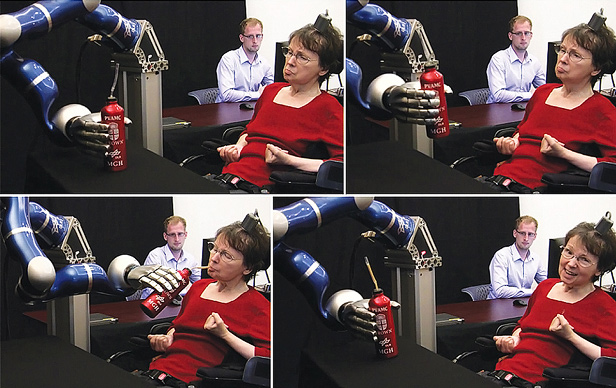Brain Chip Helps Quadriplegics Move Robotic Arms with Their Thoughts

A paralyzed patient equipped with an implanted brain chip has been able to use a robotic arm to reach for and pick up a bottle of coffee, bring it close enough to her face so she could drink from a straw, and then place the bottle back on the table.
The quadriplegic patient was outfitted with an electronic brain implant that can drive a robotic arm to reach and grasp objects (see video). A study published today in the journal Nature shows that people with the brain chips can use the devices to perform complex three-dimensional tasks that could be helpful in daily life. Furthermore, the implanted electrodes can record neuronal signals for as long as five years—longer than had been suspected. In previous studies, patients using brain implants have been able to move a cursor on a screen, but not perform complicated movements with objects in the real world.
The results are the latest announcements from a team led by John Donoghue, a neuroscientist at Brown University. Donoghue and collaborators had reported in 2006 that patients paralyzed by spinal-cord injuries could use brain-machine interfaces to drive the movement of cursors on a screen and do simple open-and-close movements with a robotic hand. Now the researchers have shown that a brain-machine interface can direct more complicated tasks. “Not only can people control a computer cursor, they can control really complex devices like a robotic arm that can carry out the functions that our own arm can do,” says Donoghue.
The brain implant is a small array that’s four millimeters on each side (“about the size of a baby aspirin,” says Donoghue) with 96 hairlike electrodes extending from one side. The device sits on the surface of the brain, and the electrodes penetrate the arm-controlling region of the motor cortex by one millimeter. The implant records the impulses of dozens of neurons. A patient’s intent to move generates these impulses, which are then transmitted to a computer that translates the patterns of electrical activity into commands that can control a robotic arm.
“What’s striking to me about this study is that it’s nicely showing, for the first time in human patients, that you can use these signals to control a robot of importance for activities of daily living for a patient,” says Andrew Jackson, a neuroscientist at Newcastle University. The researchers say that algorithmic improvements in picking up patterns of activity in the brain and interpreting those patterns were key to the advance.
The goal of the pilot clinical trial is to develop technologies that can restore the ability to communicate and move and to give independence to people with neurological disease or injury. So far, seven patients have enrolled in the trial. The two participants in this latest work both suffered from brain-stem strokes that left them unable to speak or move their limbs. At the time of the study, one patient had the implant for five months, the other for more than five years.
The longevity of the implants demonstrates that the device can pick up usable signals from the brain for years, a point of concern in the field. “When you put something into the brain, there’s a reaction to the presence of that device,” says Donoghue. Cells are damaged or displaced by the electrodes, and the brain can form scar tissue around them. But “it doesn’t seem that the reaction of the brain is a barrier to recording,” says Donoghue.
Still, the signal deteriorated over time. “Even though they are recording signals five years after the array was put in, the signals aren’t that stable day to day,” says Jackson. He points out that the jellylike tissue of the brain moves within our skull, and a rigid, fixed implant may force the brain to deform around it. “If the signals are changing day to day, would [a patient] need to recalibrate the system day to day?”
For now, the implant must be plugged into an external setup, but the Brown researchers and researchers at Blackrock Microsystems in Utah (which manufactures the implants) are working on wireless versions that are being tested in animals. Donoghue hopes that the implants can eventually drive electrical stimulation of a patient’s own muscles, circumventing the need for robotic arms. Such experiments have shown promise in nonhuman primates (for example, see a recent study from Northwestern University).
Keep Reading
Most Popular
Large language models can do jaw-dropping things. But nobody knows exactly why.
And that's a problem. Figuring it out is one of the biggest scientific puzzles of our time and a crucial step towards controlling more powerful future models.
The problem with plug-in hybrids? Their drivers.
Plug-in hybrids are often sold as a transition to EVs, but new data from Europe shows we’re still underestimating the emissions they produce.
Google DeepMind’s new generative model makes Super Mario–like games from scratch
Genie learns how to control games by watching hours and hours of video. It could help train next-gen robots too.
How scientists traced a mysterious covid case back to six toilets
When wastewater surveillance turns into a hunt for a single infected individual, the ethics get tricky.
Stay connected
Get the latest updates from
MIT Technology Review
Discover special offers, top stories, upcoming events, and more.